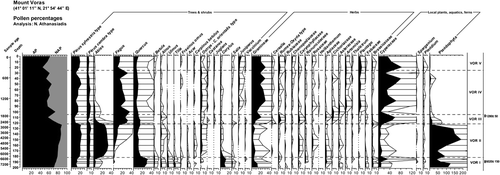Abstract
Site details
The Voras mount runs in a NNE–SSW direction, along the Greece – Former Yugoslav Republic of Macedonia borders. The small mire lies in the middle of the Greek part of Mount Voras (41° 01¢ 11″ Ν, 21° 54¢ 44″ E; 1640 m a.s.l.; size ca. 0.08 ha) about 15 km west-northwest of the town of Aridea. The groundwater-fed mire is situated in a subalpine grassland a few meters above the Fagus forest limits. A few scattered Pinus sylvestris trees are found around and above the mire at some distance. Major components of its vegetation are: Carex echinata, C. pallescens, Eriophorum angustifolium, Agrostis castellana ssp. byzantina, Nardus stricta and among the moss species: Sphagnum subsecundum, Climacium dendroides, and Dicranum scoparium. Fagus sylvatica s.l., Pinus sylvestris and rarely P. peuce form the treeline in Voras mount. The forest vegetation of high altitudes is composed mainly of Fagus and P. sylvestris interspersed with local occurrences of fir and black pine. In low altitudes oak dominated thermophilous deciduous forests occur. Geologically, there is a great variability of substrates comprised of limestone, schist, gneiss and ophioliths. The climate is characterised as humid continental, with short warm Summers (Dfb type according to Köppen) (Athanasiadis & Gerasimidis, Citation1986).
Sediment description
The core of 200 cm length was extracted in 1977. The upper 50 cm was extracted using a spade and shaped to a monolith with dimensions 50 × 10 × 10 cm.
-
0 – 89 cm: Cyperaceae peat
-
89 – 105 cm: Cyperaceae peat with clay
-
105 – 150 cm: Silt
-
129 – 192 cm: Cyperaceae peat with clay
-
105 – 150 cm: Clay and sand
Dating
Material from the monolith and 5 cm long cylindrical samples taken from multiple cores, extracted in the depths given below, were used for radiocarbon dating.
Results of the radiocarbon dating, carried out by the Institut für Radiumforschung (Bern, Swiss), are:
-
45–50 cm: 4830 + 60 BP (B-2992)
-
105–110 cm: 1280 + 50 BP (B-2993)
-
187–192 cm: 6020 + 150 BP (B-2994)
The problem of reversed dating values was overcome by comparing the age of similar phases of vegetation development in the pollen diagrams of Kastoria and Litochoro (Bottema, Citation1974; Athanasiadis, Citation1975) with that of Voras. The Voras dating in the interval 105 – 110 cm was found to fit better in the time scale of the two pollen diagrams and, therefore, it was used for the calculation of dates for the entire diagram.
Interpretation
The pollen sum (100%) includes all pollen grains except those of aquatic plants, ferns, and Cyperaceae, the latter dominate the local vegetation.
The diagram () covers a period of ca. 7500 years, during which Pinus shows a more or less firm presence. Three major successive phases all marked by the dominance of a different vegetation type can be distinguished: 1. Thermophilous deciduous forests phase; 2. Fir forests phase; and 3. Beech forests phase. Based on the trend of the major tree pollen curves, five zones can be defined, as follows:
-
VOR 1 (200 – 182 cm). – The lower zone is characterised by the dominance of thermophilous deciduous forests, as indicated by the curves of the related trees and especially of Quercus and Corylus. The marked presence of Pinus and Abies is in contrast to that of Fagus which scores very low pollen values.
-
VOR 2 (182 – 122 cm). – Quercus, Corylus and the other components of the thermophilous deciduous woodlands decrease and retain low values throughout the rest of the period covered by the diagram. During this period Abies shows an abrupt increase and scores high pollen values. Pinus pollen values increase in a similar manner while Fagus begins to increase gradually.
-
VOR 3 (122 – 105 cm). – The forest vegetation undergoes an abrupt reduction in which almost all of its components except Fagus score low pollen values. The striking expansion of Fagus will be preserved in the following phases despite any observed fluctuations. The observed sharp and abrupt reduction of Pinus and Abies can be attributed to their natural replacement by Fagus, or natural phenomena (fire events) or even human intervention in the coniferous belt. Moreover, for Abies this phase is the turning point in remaining a limited component of the Voras mount forest vegetation.
-
VOR 4 (105 – 25 cm). – The dominance of Fagus and secondly of Pinus is characteristic of the zone. In the end of this zone Fagus shows a short but sharp expansion.
-
VOR 5 (25 – 0 cm). – The lowest values of the forest cover in total are recorded during the starting of the upper zone. The following increase of all arboreal species pollen values and especially Pinus and Fagus reflect an expansion of forest vegetation cover.
References
- Athanasiadis , N. 1975 . Zur postglazialen Vegetationsentwicklung von Litochoro Katerinis und Pertouli Trikalon (Griechenland) . Flora , 164 : 99 – 132 .
- Athanasiadis , N. and Gerasimidis , A. 1986 . Zur postglazialen Vegetationsentwicklung von Voras-Gebirge (Almopia, Griechenland) . Sci. Ann. Dept. For. Nat. Environ. Univ. Thessaloniki , 38 : 211 – 249 . (in Greek & German Summary)
- Bottema , S. 1974 . Late Quaternary vegetation history of northwestern Greece , Groningen : Fac. Sci. Univ. Groningen. PhD Diss .
